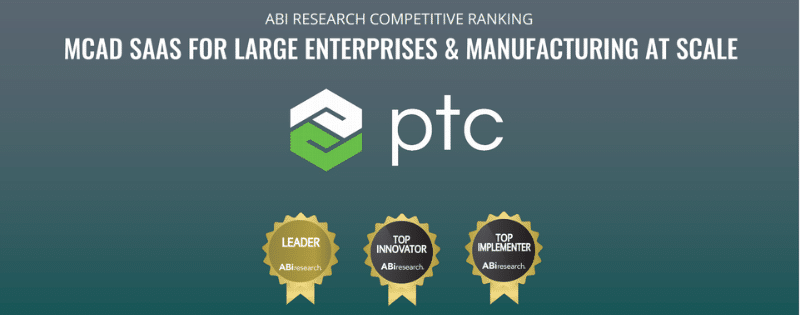If you are looking for 3D CAD software, you will more than likely evaluate Solid Edge vs Creo as they are both highly functional and well-known leaders in the field. Looking for a 3D CAD modeling system can be confusing. Evaluating multiple software systems using a feature by feature comparison is frustrating, time-consuming, and expensive—plus, it rarely yields any differentiating functionality. Then how should you evaluate these 3D CAD software solutions? In our opinion, the best way to compare Solid Edge vs Creo is to focus on the track record and ongoing vision of the companies.
3D CAD Software Comparison: Feature Breakdown
Product Vision
Solid Edge 2020 includes support for augmented reality (AR), model-based definition, 2D nesting, improved collaboration, and the ability to digitize the entire design to the manufacturing process. It sounds impressive—until you realize that Creo has had all that for several releases. When it comes to product vision, Creo is way out in front of its competitors.
Creo has consistently included the latest technologically advanced features in their solution.
3D CAD Modeling
This is the core capability of what both products do, and they are both good at it. Creo has multiple extensions that enable companies to fine-tune their Creo solution. Solid Edge has an interesting ability to geometrically compare two versions of a 3D model. Creo has had similar capabilities since at least 2014. Reviewing the datasheet for Solid Edge 2020 will show that everything added to the latest release has been available with Creo for a very long time. In the Solid Edge vs Creo showdown, Creo is the clear functional winner.
Solid Edge is just now adding the same advanced 3D CAD modeling features that Creo has had for at least 5 years.
Ease of Use
Creo’s refreshed user interface (UI) makes working with it as simple as working in a web browser. Unfortunately for Solid Edge, other than the newly added functionalities like AR, most of the platform still looks like a client-server era application. Another win for Creo in the Solid Edge vs Creo comparison.
Creo has a beautiful and intuitive UI.
Industry Focus
PTC, Creo’s parent company, has been a mainstay in CAD and modeling for manufacturing and related industries since its inception. Creo has the tools and functionalities needed to address the specific needs of specific industries, including:

- Smart cities
- Retail and consumer products
- Oil and gas
- Manufacturing
- Life sciences
- Automotive
- Aerospace and defense
Solid Edge addresses several industries as well, including:
- Aerospace supply chain companies
- Industrial machinery
- Industrial food processing equipment
- Agricultural machinery
- Energy & utility equipment design
- Medical devices
- Consumer durables
- Academic
Solid Edge individually calls out several types of equipment manufacturing that Creo has combined under manufacturing, but there is little or no difference between manufacturing industrial machinery and industrial food processing equipment. Unless you are in a specific industry that the other product doesn’t cover at all, there is little to distinguish one product over the other in terms of industry focus.
Both Solid Edge and Creo have the tools you need – regardless of what industry you are in.
Collaboration and Integration
Solid Edge offers 5GB of free storage, which is nice, but it isn’t much when it comes to 3D CAD files. Users can access and view files from any device that has the right viewer. Files can be securely shared with customers, partners, and teams across the world. Security features allow individuals to “view and download” or “view only” on a file-by-file basis. Users can markup drawings online, so other users have access to their thoughts.
Creo has had online collaboration capabilities for years. Creo’s security is flexible and strong, supporting file security by role with individual overrides when needed. Users can open and work with files from any CAD system, so there is no need to enforce a specific file format or to convert files before posting. Interacting with partners and customers is simple and seamless. Creo’s Unite technology platform is the standard for measuring collaboration in 3D CAD.
Creo and Solid Edge include robust security and collaboration features.
Online Education and Support
Solid Edge runs periodic educational conferences it has dubbed “Solid Edge University”, but even though Siemens positions them as education, they are more like marketing and sales events. However, the online resource library offers many educational topics that range from simple to advanced, and all available at no additional cost. There is also a series of on-demand webinars for training along with online help and support.
Creo offers similar resources and a lot more. PTC Academic, for example, is an outreach program that allows students and educators to connect, bridging academic learning and real‑world experience. PTCU.com provides user subscriptions access to classes that range from basic to advanced. There is also a robust online user community, on-demand webinars, and developer portals for sharing ideas and enhancements.
Both platforms include a range of online resources to help both new and advanced users learn additional skills.
Solid Edge vs Creo Comparison Winner
When comparing Solid Edge vs Creo, it isn’t easy to come up with meaningful differences—except for the intangibles of vision and industry commitment, where Creo wins in spades. If you look at functionality and even high-level education and support, it’s hard to find a “gotcha” on either side of the equation. Now we admit to a bias—after all, we’re one of PTC’s top resellers—but all our experience in this area says that Creo is the best product for almost any company, especially if you want to integrate with other PTC solutions like Vuforia Studio, ThingWorx, or Windchill.
 If you’d like to see the results of other software comparisons besides Solid Edge vs Creo, check out some of our other posts.
If you’d like to see the results of other software comparisons besides Solid Edge vs Creo, check out some of our other posts.
Or, if you are ready to purchase Creo, fill out the form below.

